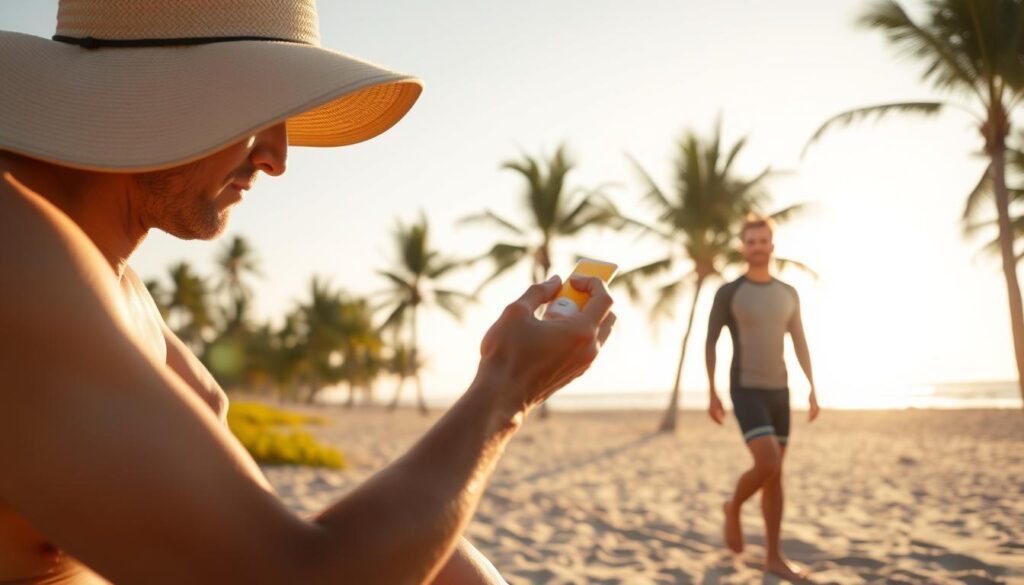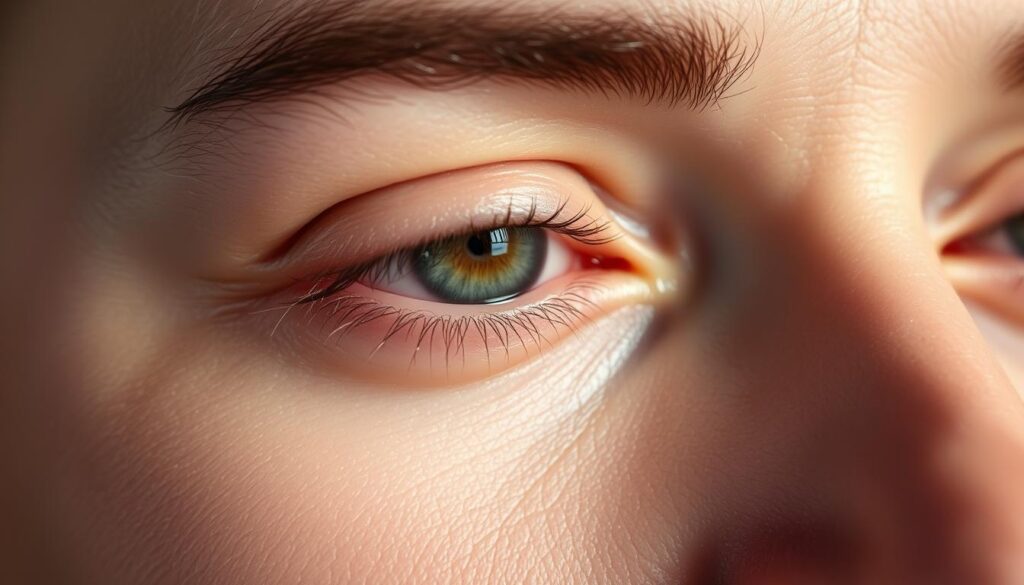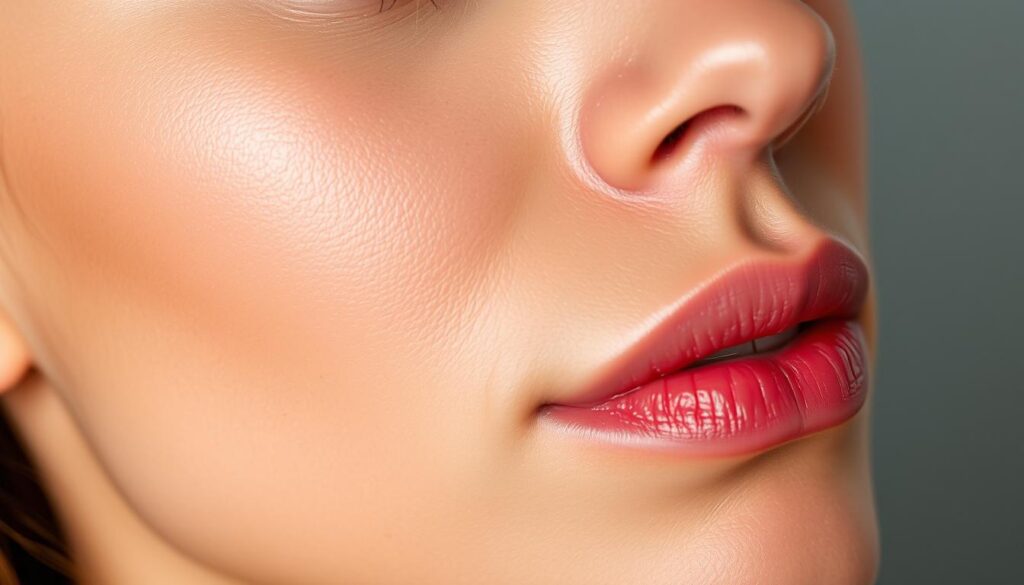Spending time outdoors can be refreshing, but it’s important to consider the effects on your skin. Over time, exposure without proper protection can lead to visible signs like wrinkles, spots, and even more serious concerns such as skin cancer. Early intervention is key to maintaining healthy skin and preventing long-term issues.
Common areas like the face, arms, and neck are often most affected. Persistent redness or freckles can be early indicators that your skin needs attention. Using sunscreen with zinc and an SPF of at least 30 is a simple yet effective step to protect yourself1.
There are also various treatment options available, from retinol to laser therapies, that can help improve skin texture and reduce visible damage. Taking proactive steps now can make a significant difference in your skin’s health and appearance.
Understanding Sun Damage and UV Exposure
Understanding the science behind UV rays can help you protect your skin effectively. The sun emits two types of ultraviolet rays: UVA and UVB. Both play a role in skin damage, but they affect your skin in different ways.
The Science of UVA and UVB
UVA rays penetrate deep into the skin’s layer, causing long-term damage like wrinkles and loss of elasticity. They account for about 95% of UV radiation reaching the Earth2. UVB rays, on the other hand, primarily affect the outer layer, leading to sunburns and direct DNA damage2.
Both types of rays contribute to the breakdown of collagen, a protein that keeps your skin firm. Over time, this leads to visible signs like fine lines and sagging2.
How UV Rays Affect Your Skin
Even a short time in the sun can impact your skin’s outer layer. UVA rays, in particular, degrade collagen fibers, accelerating the aging process2. This is why broad-spectrum sunscreen is essential—it protects against both UVA and UVB rays.
During peak hours, typically between 10 a.m. and 2 p.m., UV exposure is most intense2. Wearing sunscreen daily, even on cloudy days, can help shield your skin from these harmful effects.
By understanding how UV rays work, you can take proactive steps to maintain your skin’s health and prevent premature aging.
Recognizing the Early Signs of Sun Damage
Your skin often shows subtle signs of wear before major issues arise. By paying attention to these early indicators, you can take steps to maintain its health and appearance. Wrinkles, spots, and uneven pigmentation are common signals that your skin needs care.
Identifying Wrinkles, Spots, and Hyperpigmentation
Fine lines and wrinkles are often the first visible signs of stress on your skin. These develop as collagen breaks down in the layer skin, leading to a loss of firmness3. Over time, deeper lines may form, especially in areas exposed to environmental factors.
Spots and hyperpigmentation are another key indicator. Freckles, known as “ephelides,” and larger tan spots, called “solar lentigos,” are both caused by prolonged exposure3. These uneven patches can make your skin appear older than it is.
Hyperpigmentation is a common concern, often driving people to seek treatment. This condition is linked to chronic stress on skin cells, which can accelerate aging3. Early detection and proper protection can help reduce these effects.
The Role of Cell Damage and Vitamin Deficiencies
Damage to skin cells plays a significant role in aging. Overexposure can harm the cell structure, leading to visible changes like wrinkles and spots4. A lack of essential vitamins, such as vitamin C and E, can further weaken your skin’s ability to repair itself.
By addressing these issues early, you can prevent more serious concerns like cancer. Regular use of sunscreen with an SPF of 30 or higher is a simple yet effective way to protect your skin4.
| Sign | Cause | Prevention |
|---|---|---|
| Wrinkles | Collagen breakdown | Use sunscreen daily |
| Spots | Prolonged exposure | Wear protective clothing |
| Hyperpigmentation | Chronic stress on cells | Apply broad-spectrum sunscreen |
Being proactive about your skin’s health can make a big difference. Pay attention to changes in texture and tone, and take steps to protect your skin from further stress.
Sun Damage: How to Reverse and Prevent It
Protecting your skin from environmental stressors is essential for maintaining its health and appearance. There are several effective ways to care for your skin, ranging from simple at-home routines to advanced professional treatments. The right approach depends on the severity of the damage and your personal skin care needs.
Key Strategies for Prevention and Reversal
One of the most effective ways to care for your skin is by using topical treatments. Retinoids, for example, can normalize damaged cells and boost collagen production5. These are available in creams, gels, and liquids, making them easy to incorporate into your routine.
For deeper damage, professional treatments like chemical peels and laser therapies can make a significant difference. Chemical peels vary in depth, with deeper peels often used for chronic issues6. Laser treatments, such as CO2 and erbium lasers, remove thin layers of skin to reduce wrinkles and dark spots5.
Another innovative option is microneedling with radio frequency. This treatment improves collagen levels and is suitable for all skin types, including skin of color6. Combining it with PRP (platelet-rich plasma) can extend visible results for up to three months6.
Here’s a quick comparison of popular treatments:
| Treatment | Benefits | Downtime |
|---|---|---|
| Chemical Peel | Exfoliates skin, reduces spots | 1-2 weeks |
| Laser Therapy | Stimulates collagen, reduces wrinkles | 1 week |
| Microneedling | Improves texture, minimal risk | 2-3 days |
By combining preventative measures with targeted treatments, you can achieve healthier, more radiant skin. Always consult a dermatologist to determine the best way to care for your unique needs.
Preventative Strategies to Protect Your Skin
Shielding your skin from harmful rays requires consistent care and smart habits. By adopting the right practices, you can minimize the risk of visible signs like spots and uneven tone. Let’s explore the best ways to keep your skin healthy and radiant.
Broad-Spectrum Sunscreen and Protective Clothing
Using broad-spectrum sunscreen is one of the most effective ways to guard against harmful rays. Look for products with an SPF of 30 or higher to block both UVA and UVB rays7. Daily application can reduce the risk of skin aging by 24%8.
Protective clothing also plays a key role. Wear long sleeves, wide-brimmed hats, and sunglasses to cover vulnerable areas. Fabrics with UPF (Ultraviolet Protection Factor) offer added defense against prolonged exposure8.

Avoiding Peak Sun Hours
Limiting time outdoors during peak hours, typically between 10 a.m. and 4 p.m., can significantly reduce your exposure8. During these times, UV radiation is most intense, increasing the risk of acid-related skin damage.
If you must be outside, seek shade whenever possible. Combining sunscreen with additional measures like hats and umbrellas provides comprehensive protection8.
| Strategy | Benefit | Tips |
|---|---|---|
| Broad-Spectrum Sunscreen | Blocks UVA and UVB rays | Apply daily, even on cloudy days |
| Protective Clothing | Covers vulnerable areas | Choose UPF-rated fabrics |
| Avoid Peak Hours | Reduces intense exposure | Seek shade between 10 a.m. and 4 p.m. |
By incorporating these strategies into your routine, you can protect your skin from harmful rays and maintain its health. Consistency is key to preventing long-term concerns.
Rejuvenating Treatments for Damaged Skin
Revitalizing your skin is easier than you think with the right treatments. Whether you’re looking to reduce wrinkles or improve texture, there are options for every need. From at-home remedies to professional procedures, these solutions can help you achieve a more youthful appearance.
Topical Treatments and At-home Remedies
Using topical treatments is a simple way to address signs of aging. Retinol, for example, stimulates cell turnover and reduces the appearance of fine lines9. It’s safe for damaged skin but should always be paired with sunscreen due to increased sensitivity to light9.
Antioxidant-rich serums are another great option. These products protect your skin from environmental stressors and promote a brighter complexion. For noticeable improvement, consistent use over 4-12 weeks is recommended9.
Professional Procedures: Chemical Peels and Laser Therapy
For deeper concerns, professional treatments like chemical peels and laser therapy can make a significant change. Chemical peels exfoliate the skin, reducing spots and improving texture9. Downtime typically lasts 3-5 days, making it a convenient option for many9.
Laser therapy, such as Fraxel® or IPL, targets wrinkles and stimulates collagen production. These treatments require 1-3 sessions for visible results, with downtime ranging from 3-7 days9. Costs vary, with Fraxel® sessions starting at $80010.
| Treatment | Benefits | Downtime |
|---|---|---|
| Chemical Peel | Exfoliates, reduces spots | 3-5 days |
| Laser Therapy | Reduces wrinkles, boosts collagen | 3-7 days |
| Microneedling | Improves texture, minimal risk | 1-3 days |
If you’re unsure which treatment is right for you, consult a dermatologist. They can assess your skin’s needs and recommend the best approach for lasting results.
Lifestyle and Nutritional Approaches to Skin Rejuvenation
Nutrition and lifestyle choices play a vital role in maintaining youthful skin. By making simple adjustments to your daily habits, you can boost your skin’s natural repair processes and enhance its overall health. Let’s explore how diet, hydration, and sleep can transform your skin’s appearance.
Anti-Aging Diet and Antioxidants
An anti-aging diet rich in antioxidants can protect your skin’s surface from daily stressors. Foods like berries, spinach, and nuts are packed with nutrients that combat free radicals and promote cell repair11. For example, lycopene in watermelon absorbs UVA and UVB radiation, but it may take weeks of daily consumption to show visible results11.
Green tea is another powerful option. Its flavanol EGCG has been shown to reduce skin damage from UVA light and protect collagen levels11. Incorporating these foods into your meals each year can make a noticeable difference in your skin texture.
The Importance of Hydration and Sleep
Hydration is essential for maintaining your skin’s elasticity and smoothness. Drinking enough water each day helps flush out toxins and keeps your surface looking fresh. Pair this with a consistent sleep schedule to support your skin’s natural repair cycle12.
Studies show that irregular sleep patterns can disrupt the skin’s protective cycle, making it more vulnerable to damage11. Aim for 7-9 hours of quality sleep each night to give your skin the rest it needs to thrive.
Here are some actionable tips to integrate these changes into your routine:
- Include antioxidant-rich foods like tomatoes, carrots, and green tea in your diet.
- Drink at least 8 glasses of water daily to stay hydrated.
- Establish a bedtime routine to ensure consistent, restful sleep.
By focusing on these lifestyle and nutritional approaches, you can improve your skin texture and reduce the effects of skin damage. Small changes today can lead to lasting benefits for your skin’s health and appearance.
The Role of Professional Dermatological Care
Taking care of your skin often requires more than just at-home remedies. While daily routines like sunscreen and protective clothing are essential, professional care can address deeper concerns. Consulting a dermatologist is a critical step in managing persistent issues like uneven texture or visible signs of damaged skin.
When to Consult a Dermatologist
If you notice changes in your skin’s texture or appearance, it’s time to seek expert advice. Persistent redness, dark spots, or unusual growths may indicate underlying issues that need attention13. A dermatologist can assess your skin’s condition and recommend the right type of treatment for your needs.
Professional procedures like chemical peels or laser therapy can make a significant effect on damaged skin. These treatments target deeper layers, improving tone and reducing visible signs of aging14. For example, intense pulsed light (IPL) treatments are effective for redness, broken veins, and brown spots14.
Here’s when you should consider booking a consultation:
- You notice persistent changes in your skin’s appearance.
- At-home remedies aren’t improving the condition.
- You have a family history of skin concerns.
Combining professional care with daily habits like wearing protective clothing and sunscreen ensures comprehensive protection. Taking this step can help you achieve healthier, more radiant skin.
Conclusion
Caring for your skin requires a mix of daily habits and professional expertise. From using broad-spectrum sunscreen to incorporating key ingredients like retinol, small changes can make a big difference. These steps not only protect against sunburn but also improve your skin’s health over time15.
Combining at-home treatments with professional care ensures comprehensive protection. Procedures like chemical peels and laser therapy target deeper layers, enhancing texture and tone16. Regular consultations with a dermatologist can help address persistent concerns effectively.
Remember, consistency is key. Apply sunscreen daily, stay hydrated, and prioritize sleep to support your skin’s natural repair process. By taking these steps, you can maintain a radiant and healthy complexion for years to come.



